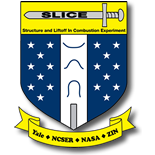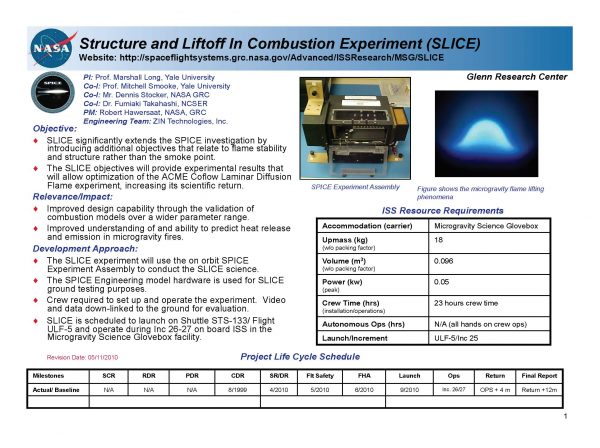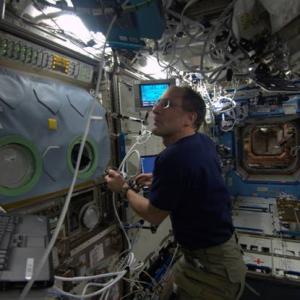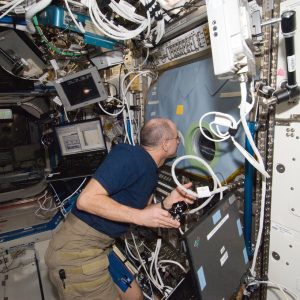SLICE
Structure & Liftoff in Combustion Experiment (SLICE)

Coflow laminar diffusion flames are especially valuable for studies of combustion because of the availability of accurate numerical modeling with that flame configuration. In particular, excellent agreement can be achieved when the flow conditions are such that the flame detaches and lifts above (i.e., moves downstream of) the nozzle. A coupled experimental and numerical investigation can enable validation and improvements to combustion modeling. For example, the image to the right is not a photo, but a numerical simulation of a 40% ethylene flame. Enhanced modeling capability is important because it can reduce time and cost in the design of practical combustion devices. Furthermore, flame attachment to (or detachment from) a burner or condensed-fuel surface is of essential importance in both combustion systems and fire safety. The flame attachment point controls the stability of the entire trailing diffusion flame.
Microgravity testing allows for greater temporal and spatial scales and a broader range of flame characteristics than can be achieved in normal gravity. As one example of the NASA-recognized value of such studies, the Coflow Laminar Diffusion Flame (CLD Flame) experiment of Marshall B. Long and Mitchell D. Smooke (both of Yale U.) is currently in development for conduct in the Combustion Integrated Rack (CIR) on the International Space Station, as part of the Advanced Combustion via Microgravity Experiments (ACME) project.
The overall goal of the proposed study is to improve our understanding of the physical and chemical processes controlling diffusion (i.e., non-premixed) flame structure and lifting phenomena (i.e., stabilization) and to provide for rigorous testing of numerical models, including thermal radiation, soot formation, and detailed chemical kinetics. As part of this aim, an important purpose of the SLICE investigation is to conduct preliminary microgravity studies that will maximize the scientific return of the subsequent CLD Flame experiment and mitigate associated risks. In other words, SLICE is a precursor to the CLD Flame experiment.
Objectives
For diffusion flames of methane, ethylene, and selected nitrogen dilutions of each fuel burning in a coflow of air:
(1) Characterize the structure of the flame, especially its base (i.e., stabilizing region), from attached through lifted conditions as a function of the fuel, burner diameter, and flow conditions.
(2) Identify the liftoff velocity limits as a function of the fuel and burner diameter.
Approach
Flame liftoff was previously studied in a glovebox on the space shuttle, with the Enclosed Laminar Flames (ELF) investigation which flew as part of the STS-87 mission. The SLICE experiment uses SPICE hardware which was based directly on the earlier ELF hardware. Compared to ELF, the SLICE experiment provides superior imaging and a much wider variety of test conditions.
The experimental hardware for the Smoke Points In Co-flow Experiment (SPICE), of David L. Urban (NASA Glenn) and Peter B. Sunderland (U. Maryland), which is currently onboard the International Space Station, was built to allow studies of coflow laminar diffusion flames. The SPICE hardware is within the ISS MSG in the image to the right. While the SPICE investigation has been specifically focused on a study of soot production and oxidation within flames, the hardware can be used without modification to conduct the SLICE experiment. In terms of the experimental hardware, the only additional requirements for SLICE are more fuel (i.e., gas bottles), recording media, and minor hardware elements such as new nozzle(s). The three existing SPICE nozzles are all smaller than the nozzle planned for the CLD Flame experiment. Of course, the SLICE testing could most benefit the CLD Flame experiment by bracketing and/or including the same nozzle size. It is also possible that screen(s) would be flown to alter the velocity profile of the coflow.
The SLICE operating procedures will have some differences to the standard SPICE procedures given the differing objectives. However, those changes are fully within the capabilities of the SPICE hardware, as demonstrated by exploratory testing that has already been conducted on orbit. As a simple example, the standard SPICE procedure calls for a fixed air velocity and an increase of the fuel flow until the smoke point is reached. In contrast, SLICE will include testing where the fuel flow is fixed and the air velocity is incrementally increased until the diffusion flame detaches and lifts off from the nozzle. In all cases, still and video measurements of the flame structure will be made for comparison with detailed numerical computations. Given that the capture of the lifting processes in normal gravity is extremely difficult, SLICE will provide valuable photographic observations on the transient flame behavior.
The lifted nature of the flames can be discerned from the flame shape in the example images (which are not at the same scale) and the distance from the nozzle tip (which is not visible). While the case(s) on the left may look similar to attached flames, the outward fuel-lean flare of each flame’s base reveals it’s lifted nature.
Gallery
SLICE Contacts
Project Manager: Robert Hawersaat, NASA Glenn Research Center
Principal Investigator: Prof. Marshall Long, Yale University
Co-Investigator: Prof. Mitchell Smooke, Yale University
Co-Investigator: Mr. Dennis Stocker, NASA Glenn Research Center
Co-Investigator: Dr. Fumiaki Takahashi, NCSER
Engineering Team: ZIN Technologies, Inc.



